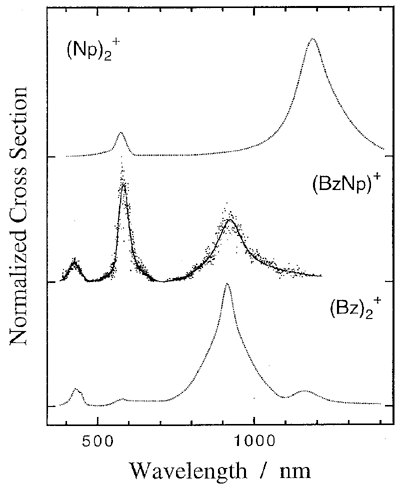
Masaki MATSUMOTO (Kyushu Univ.), Yoshiya INOKUCHI (Kyusyu Univ.), Kazuhiko OHASHI and Nobuyuki NISHI
[J. Phys. Chem. 101, 4574 (1997)]
The electronic spectrum of the benzene-naphthalene hetero-dimer cation is measured in the 400-1200 nm region by photodissociation spectroscopy. Figure 1 shows the photodissociation spectra of benzene-naphthalene hetero-dimer cation (BzNp)+ in the middle. On the top and the bottom, those of naphthalene dimer cation (Np)2+, and benzene dimer cation (Bz)2+ are shown for the references. The most intense band at 580 nm in the middle spectrum is assigned to a local excitation (LE) band of the naphthalene cation chromophore. In addition to this band, an LE band of the benzene cation chromophore of the hetero-dimer is observed at nearly the same position (430 nm) as that of the benzene homo-dimer cation. The observation indicates that the positive charge stays on the benzene molecule in some probability, although the ionization potential of benzene is by 1.10 eV higher than that of naphthalene. The spectrum of the hetero-dimer cation also shows an intermolecular charge transfer(CT) band around 920 nm. On the basis of the position of the CT band as well as the intensity of the LE band relative to that of the homo-dimer, the probability of finding the charge on the benzene molecule is analyzed to be approximately 9 %.

Figure 1. Photodissociation spectra of (Np)2+(top), (BzNp)+(middle), and (Bz)2+. Amplitudes of the three spectra are normalized independently; relative intensities of them are just arbitrary to one another.